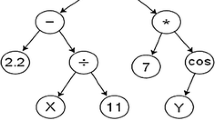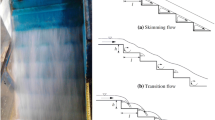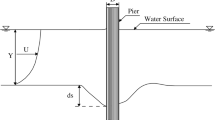Abstract
Compound broad-crested weir is a typical hydraulic structure that provides flow control and measurements at different flow depths. Compound broad-crested weir mainly consists of two sections; first, relatively small inner rectangular section for measuring low flows, and a wide rectangular section at higher flow depths. In this paper, series of laboratory experiments was performed to investigate the potential effects of length of crest in flow direction, and step height of broad-crested weir of rectangular compound cross-section on the discharge coefficient. For this purpose, 15 different physical models of broad-crested weirs with rectangular compound cross-sections were tested for a wide range of discharge values. The results of examination for computing discharge coefficient were yielded by using multiple regression equations based on the dimensional analysis. Then, the results obtained were also compared with genetic programming (GP) and artificial neural network (ANN) techniques to investigate the applicability, ability, and accuracy of these procedures. Comparison of results from the GP and ANN procedures clearly indicates that the ANN technique is less efficient in comparison with the GP algorithm, for the determination of discharge coefficient. To examine the accuracy of the results yielded from the GP and ANN procedures, two performance indicators (determination coefficient (R 2) and root mean square error (RMSE)) were used. The comparison test of results clearly shows that the implementation of GP technique sound satisfactory regarding the performance indicators (R 2 = 0.952 and RMSE = 0.065) with less deviation from the numerical values.











Similar content being viewed by others
References
Ayoubloo MK, Azamathulla HM, Jabbari E, Mahjoobi J (2004) Model tree approach for estimation of critical submergence for horizontal intakes in open channel flows. Expert Syst with Appl (ESWA) 38(8):10114–10123
Azamathulla HM, Guven A, Demir YK (2008) Linear genetic programming to scour below submerged pipeline. Ocean Eng 38(8):995–1000
Azamathulla HM, Ghani AA, Zakaria NA, Guven A (2010) Genetic programming to predict bridge pier scour. J Hydraul Eng ASCE 136(3):165–169
Azimi AH, Rajaratnam N (2009) Discharge characteristics of weirs of finite crest length. J Hydraul Eng ASCE 120(2):105–112
Azmathulla HM, Ghani AAb (2009) Genetic programming for longitudinal dispersion coefficients in streams. Water Resour Manag 25(6):1537–1544
Bilhan O, Emiroglu ME, Kisi O (2010) Application of two different neural network techniques to lateral outflow over rectangular side weirs located on a straight channel. Adv Eng Softw 41:831–837
Boiten W (2002) Flow measurement structures. Flow Meas Instrum 13:203–207
Boiten W, Pitlo HR (1982) The V-shaped broad-crested weir. J Irrig Drain Eng 108(2):142–160
French RH (1987) Open-channel hydraulics. McGraw-Hill, New York
Gonzalez CA, Chanson H (2007) Experimental measurements of velocity and pressure distributions on a large broad-crested weir. Flow Meas Instrum 18(3–4):107–113
Hager WH, Schwalt M (1994) Broad-crested weir. J Irrig Drain Eng 120(1):13–26
Johari A, Habibagahi G, Ghahramani A (2006) Prediction of soil–water characteristic curve using genetic programming. J Geotech Geoenviron Eng 132(5):661–665
Koza JR (1992) Genetic programming: on the programming of computers by means of natural selection. MIT, Mass
Muttil N, Chau KW (2006) Neural network and genetic programming for modeling coastal algal blooms. Int J Environ Pollut 28(3–4):223–238
Qnet (2000) Neural Network Modeling for Windows 95/98/XP, http://qnetv2k.com/Qnet2000Manual/contents2000.htm
Ramamurthy AS, Udoyara ST, Rao MVJ (1988) Characteristic of square-edged and round-nosed broad-crested weirs. J Irrig Drain Eng 114(1):61–73
Ranga Raju KG (1993) Flow through open channel. McGraw-Hill, New York
Rantz SE (2005) Measurement and computation of stream flow, Volume 2, Computation of discharge, U.S. Geological Survey, Water Supply Paper 2175.
Salmasi F (2010) An artificial neural network (ANN) for hydraulics of flows on stepped chutes. European Journal of Scientific Research 45(3):450–457, ISSN 1450-216X
Salmasi F, Khatibi R, Ghorbani MA (2011) A study of friction factor formulation in pipes using artificial intelligence techniques and explicit equations. Turkish J Eng Env Sci 35:1–18. doi:10.3906/muh-1008-30, TUBITAK
Sarker MA, Rhodes DG (2004) Calculation of free-surface profile over a rectangular broad-crested weir. Flow Meas Instrum 15(4):215–219
Author information
Authors and Affiliations
Corresponding author
Appendix
Appendix
Rights and permissions
About this article
Cite this article
Salmasi, F., Yıldırım, G., Masoodi, A. et al. Predicting discharge coefficient of compound broad-crested weir by using genetic programming (GP) and artificial neural network (ANN) techniques. Arab J Geosci 6, 2709–2717 (2013). https://doi.org/10.1007/s12517-012-0540-7
Received:
Accepted:
Published:
Issue Date:
DOI: https://doi.org/10.1007/s12517-012-0540-7




